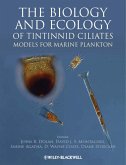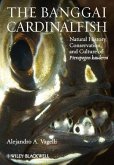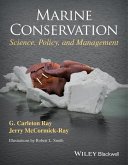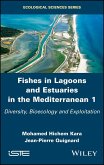The Biology and Ecology of Tintinnid Ciliates (eBook, ePUB)
Models for Marine Plankton
Redaktion: Dolan, John R.; Stoecker, Diane K.; Coats, D. Wayne; Agatha, Sabine; Montagnes, David J. S.


Alle Infos zum eBook verschenken

The Biology and Ecology of Tintinnid Ciliates (eBook, ePUB)
Models for Marine Plankton
Redaktion: Dolan, John R.; Stoecker, Diane K.; Coats, D. Wayne; Agatha, Sabine; Montagnes, David J. S.
- Format: ePub
- Merkliste
- Auf die Merkliste
- Bewerten Bewerten
- Teilen
- Produkt teilen
- Produkterinnerung
- Produkterinnerung

Hier können Sie sich einloggen

Bitte loggen Sie sich zunächst in Ihr Kundenkonto ein oder registrieren Sie sich bei bücher.de, um das eBook-Abo tolino select nutzen zu können.
Planktonic protists both produce and consume most of the primary production in the world ocean. They not only play key roles in the oceans but also represent an astounding amount of diversity: ecological morphological and genetic. However, for most taxa their ecology, morphology, phylogeny and biogeography are either poorly known or appear to be largely unrelated to one another; this hinders our understanding of their biology as well as interpretation of emerging genetic data. Tintinnid ciliates represent a singular exception. Compared to nearly all other groups of planktonic protists, there…mehr
- Geräte: eReader
- mit Kopierschutz
- eBook Hilfe
- Größe: 23.09MB
![The Biology and Ecology of Tintinnid Ciliates (eBook, PDF) The Biology and Ecology of Tintinnid Ciliates (eBook, PDF)]() The Biology and Ecology of Tintinnid Ciliates (eBook, PDF)104,99 €
The Biology and Ecology of Tintinnid Ciliates (eBook, PDF)104,99 €![The Banggai Cardinalfish (eBook, ePUB) The Banggai Cardinalfish (eBook, ePUB)]() Alejandro A. VagelliThe Banggai Cardinalfish (eBook, ePUB)144,99 €
Alejandro A. VagelliThe Banggai Cardinalfish (eBook, ePUB)144,99 €![In the Name of Sharks (eBook, ePUB) In the Name of Sharks (eBook, ePUB)]() François SaranoIn the Name of Sharks (eBook, ePUB)14,99 €
François SaranoIn the Name of Sharks (eBook, ePUB)14,99 €![Biological Sampling in the Deep Sea (eBook, ePUB) Biological Sampling in the Deep Sea (eBook, ePUB)]() Biological Sampling in the Deep Sea (eBook, ePUB)139,99 €
Biological Sampling in the Deep Sea (eBook, ePUB)139,99 €![Antarctic Ecosystems (eBook, ePUB) Antarctic Ecosystems (eBook, ePUB)]() Antarctic Ecosystems (eBook, ePUB)127,99 €
Antarctic Ecosystems (eBook, ePUB)127,99 €![Marine Conservation (eBook, ePUB) Marine Conservation (eBook, ePUB)]() G. Carleton RayMarine Conservation (eBook, ePUB)41,99 €
G. Carleton RayMarine Conservation (eBook, ePUB)41,99 €![Fishes in Lagoons and Estuaries in the Mediterranean 1 (eBook, ePUB) Fishes in Lagoons and Estuaries in the Mediterranean 1 (eBook, ePUB)]() Mohamed Hichem KaraFishes in Lagoons and Estuaries in the Mediterranean 1 (eBook, ePUB)139,99 €
Mohamed Hichem KaraFishes in Lagoons and Estuaries in the Mediterranean 1 (eBook, ePUB)139,99 €-
-
-
Dieser Download kann aus rechtlichen Gründen nur mit Rechnungsadresse in A, B, BG, CY, CZ, D, DK, EW, E, FIN, F, GR, HR, H, IRL, I, LT, L, LR, M, NL, PL, P, R, S, SLO, SK ausgeliefert werden.
- Produktdetails
- Verlag: John Wiley & Sons
- Seitenzahl: 304
- Erscheinungstermin: 13. September 2012
- Englisch
- ISBN-13: 9781118358122
- Artikelnr.: 37343984
- Verlag: John Wiley & Sons
- Seitenzahl: 304
- Erscheinungstermin: 13. September 2012
- Englisch
- ISBN-13: 9781118358122
- Artikelnr.: 37343984
tintinnid ciliates? 2 1.2 What is a tintinnid ciliate? 3 1.3 The lorica as
the defining characteristic of tintinnid ciliates 3 1.4 History of
tintinnid studies 7 1.5 Tintinnids as model organisms for marine plankton
13 1.6 Key points 16 Acknowledgments 16 CHAPTER 2 THE TINTINNID LORICA 17
2.1 Introduction 18 2.2 Diversity formation and variability of loricae 19
2.3 Ultrastructure of loricae 32 2.4 Chemical composition of loricae 35 2.5
Lorica sedimentation 40 2.6 Key points 41 Acknowledgments 41 CHAPTER 3
SYSTEMATICS AND EVOLUTION OF TINTINNID CILIATES 42 3.1 Introduction 43 3.2
History of tintinnid taxonomy and systematics 44 3.3 Evolution of
tintinnids 49 3.4 How to read the tintinnid cladogram 64 3.5 Molecular
analysis and comparison with morphologic data 69 3.6 Systematics 75 3.7
Comparison with the evolution of related planktonic ciliates: the aloricate
choreotrichids oligotrichids and halteriids 81 3.8 Key points 83
Acknowledgments 84 CHAPTER 4 ECOPHYSIOLOGY AND BEHAVIOR OF TINTINNIDS 85
4.1 Introduction 86 4.2 Feeding 86 4.3 Growth 99 4.4 Swimming behavior 106
4.5 Response to abiotic factors and interactions with biotic factors 111
4.6 Tintinnids as models and in models 114 4.7 Key points 121
Acknowledgments 121 CHAPTER 5 PREDATORS OF TINTINNIDS 122 5.1 Introduction
123 5.2 Predators of tintinnids 133 5.3 Anti-predator defenses of
tintinnids 141 5.4 Top-down control of tintinnids 142 5.5 Importance of
tintinnids as prey for the predator 143 5.6 Tintinnids as vectors for algal
toxins 143 5.7 Key points 144 Acknowledgments 144 CHAPTER 6 PARASITES OF
TINTINNIDS 145 6.1 Background 146 6.2 Dinoflagellate parasites: morphology
and infection cycle 149 6.3 Molecular evolution of dinoflagellates
parasitizing tintinnids 160 6.4 Ecology of tintinnid parasites 165 6.5
Summary and future directions 169 6.6 Key points 169 Acknowledgments 170
CHAPTER 7 COMPARATIVE BIOLOGY OF TINTINNID CYSTS 171 7.1 Introduction 172
7.2 Morphology 173 7.3 Encystment and excystment 176 7.4 Ecological
function of cysts 182 7.5 Key points 184 Acknowledgments 185 CHAPTER 8
FOSSIL TINTINNIDS 186 8.1 Introduction: a paucity of data 187 8.2
Proterozoic tintinnids: no evidence of a beginning 187 8.3 Paleozoic
tintinnid reports: too thin to know 191 8.4 Mesozoic tintinnids and
calpionellids: same shape different composition 191 8.5 Cenozoic
tintinnids: sparse 192 8.6 Organic and agglutinated phanerozoic fossils:
the most likely candidates 193 8.7 Conclusions and perspectives 195 8.8 Key
points 197 Acknowledgments 197 CHAPTER 9 TINTINNIDS IN MICROZOOPLANKTON
COMMUNITIES 198 9.1 Ecology of microzooplankton 199 9.2 Quantitative
importance of tintinnids in microzooplankton assemblages 205 9.3
Characteristics that set tintinnids apart from other microzooplankton 211
9.4 Key points 212 Acknowledgments 213 CHAPTER 10 DIVERSITY AND
DISTRIBUTIONS OF TINTINNIDS 214 10.1 Introduction 215 10.2 Biogeography 215
10.3 Assemblages of coastal systems 233 10.4 Assemblages of open waters 239
10.5 Key points 241 Acknowledgments 243 REFERENCES 244 ORGANISM INDEX 288
SUBJECT INDEX 293
tintinnid ciliates? 2 1.2 What is a tintinnid ciliate? 3 1.3 The lorica as
the defining characteristic of tintinnid ciliates 3 1.4 History of
tintinnid studies 7 1.5 Tintinnids as model organisms for marine plankton
13 1.6 Key points 16 Acknowledgments 16 CHAPTER 2 THE TINTINNID LORICA 17
2.1 Introduction 18 2.2 Diversity formation and variability of loricae 19
2.3 Ultrastructure of loricae 32 2.4 Chemical composition of loricae 35 2.5
Lorica sedimentation 40 2.6 Key points 41 Acknowledgments 41 CHAPTER 3
SYSTEMATICS AND EVOLUTION OF TINTINNID CILIATES 42 3.1 Introduction 43 3.2
History of tintinnid taxonomy and systematics 44 3.3 Evolution of
tintinnids 49 3.4 How to read the tintinnid cladogram 64 3.5 Molecular
analysis and comparison with morphologic data 69 3.6 Systematics 75 3.7
Comparison with the evolution of related planktonic ciliates: the aloricate
choreotrichids oligotrichids and halteriids 81 3.8 Key points 83
Acknowledgments 84 CHAPTER 4 ECOPHYSIOLOGY AND BEHAVIOR OF TINTINNIDS 85
4.1 Introduction 86 4.2 Feeding 86 4.3 Growth 99 4.4 Swimming behavior 106
4.5 Response to abiotic factors and interactions with biotic factors 111
4.6 Tintinnids as models and in models 114 4.7 Key points 121
Acknowledgments 121 CHAPTER 5 PREDATORS OF TINTINNIDS 122 5.1 Introduction
123 5.2 Predators of tintinnids 133 5.3 Anti-predator defenses of
tintinnids 141 5.4 Top-down control of tintinnids 142 5.5 Importance of
tintinnids as prey for the predator 143 5.6 Tintinnids as vectors for algal
toxins 143 5.7 Key points 144 Acknowledgments 144 CHAPTER 6 PARASITES OF
TINTINNIDS 145 6.1 Background 146 6.2 Dinoflagellate parasites: morphology
and infection cycle 149 6.3 Molecular evolution of dinoflagellates
parasitizing tintinnids 160 6.4 Ecology of tintinnid parasites 165 6.5
Summary and future directions 169 6.6 Key points 169 Acknowledgments 170
CHAPTER 7 COMPARATIVE BIOLOGY OF TINTINNID CYSTS 171 7.1 Introduction 172
7.2 Morphology 173 7.3 Encystment and excystment 176 7.4 Ecological
function of cysts 182 7.5 Key points 184 Acknowledgments 185 CHAPTER 8
FOSSIL TINTINNIDS 186 8.1 Introduction: a paucity of data 187 8.2
Proterozoic tintinnids: no evidence of a beginning 187 8.3 Paleozoic
tintinnid reports: too thin to know 191 8.4 Mesozoic tintinnids and
calpionellids: same shape different composition 191 8.5 Cenozoic
tintinnids: sparse 192 8.6 Organic and agglutinated phanerozoic fossils:
the most likely candidates 193 8.7 Conclusions and perspectives 195 8.8 Key
points 197 Acknowledgments 197 CHAPTER 9 TINTINNIDS IN MICROZOOPLANKTON
COMMUNITIES 198 9.1 Ecology of microzooplankton 199 9.2 Quantitative
importance of tintinnids in microzooplankton assemblages 205 9.3
Characteristics that set tintinnids apart from other microzooplankton 211
9.4 Key points 212 Acknowledgments 213 CHAPTER 10 DIVERSITY AND
DISTRIBUTIONS OF TINTINNIDS 214 10.1 Introduction 215 10.2 Biogeography 215
10.3 Assemblages of coastal systems 233 10.4 Assemblages of open waters 239
10.5 Key points 241 Acknowledgments 243 REFERENCES 244 ORGANISM INDEX 288
SUBJECT INDEX 293







